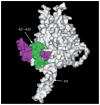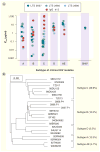Back to the future: covalent epitope-based HIV vaccine development
- PMID: 20822346
- PMCID: PMC3043596
- DOI: 10.1586/erv.10.77
Back to the future: covalent epitope-based HIV vaccine development
Abstract
Traditional HIV vaccine approaches have proved ineffective because the immunodominant viral epitopes are mutable and the conserved epitopes necessary for infection are not sufficiently immunogenic. The CD4 binding site expressed by the HIV envelope protein of glycoprotein 120 is essential for viral entry into host cells. In this article, we review the B-cell superantigenic character of the CD4 binding site as the cause of its poor immunogenicity. We summarize evidence supporting development of covalent immunization as the first vaccine strategy with the potential to induce an antibody response to a conserved HIV epitope that neutralizes genetically divergent HIV strains.
Figures






Similar articles
-
A Trimeric HIV-1 Envelope gp120 Immunogen Induces Potent and Broad Anti-V1V2 Loop Antibodies against HIV-1 in Rabbits and Rhesus Macaques.J Virol. 2018 Feb 12;92(5):e01796-17. doi: 10.1128/JVI.01796-17. Print 2018 Mar 1. J Virol. 2018. PMID: 29237847 Free PMC article.
-
Conformational Epitope-Specific Broadly Neutralizing Plasma Antibodies Obtained from an HIV-1 Clade C-Infected Elite Neutralizer Mediate Autologous Virus Escape through Mutations in the V1 Loop.J Virol. 2016 Jan 13;90(7):3446-57. doi: 10.1128/JVI.03090-15. J Virol. 2016. PMID: 26763999 Free PMC article.
-
Effect of HIV-1 envelope cytoplasmic tail on adenovirus primed virus encoded virus-like particle immunizations.Vaccine. 2016 Oct 17;34(44):5344-5351. doi: 10.1016/j.vaccine.2016.08.089. Epub 2016 Sep 12. Vaccine. 2016. PMID: 27633665 Free PMC article.
-
Antibody epitope exposure and neutralization of HIV-1.Curr Pharm Des. 2010;16(33):3729-43. doi: 10.2174/138161210794079182. Curr Pharm Des. 2010. PMID: 21128886 Review.
-
Roles of HIV-1 Env variable regions in viral neutralization and vaccine development.Curr HIV Res. 2007 Nov;5(6):542-53. doi: 10.2174/157016207782418470. Curr HIV Res. 2007. PMID: 18045110 Review.
Cited by
-
The role of natural killer (NK) cells and NK cell receptor polymorphisms in the assessment of HIV-1 neutralization.PLoS One. 2012;7(4):e29454. doi: 10.1371/journal.pone.0029454. Epub 2012 Apr 11. PLoS One. 2012. PMID: 22509241 Free PMC article.
-
Antibodies to a superantigenic glycoprotein 120 epitope as the basis for developing an HIV vaccine.J Immunol. 2012 Dec 1;189(11):5367-81. doi: 10.4049/jimmunol.1200981. Epub 2012 Oct 22. J Immunol. 2012. PMID: 23089396 Free PMC article.
-
Post-Immune Antibodies in HIV-1 Infection in the Context of Vaccine Development: A Variety of Biological Functions and Catalytic Activities.Vaccines (Basel). 2022 Mar 2;10(3):384. doi: 10.3390/vaccines10030384. Vaccines (Basel). 2022. PMID: 35335016 Free PMC article. Review.
-
Immunisation With Immunodominant Linear B Cell Epitopes Vaccine of Manganese Transport Protein C Confers Protection against Staphylococcus aureus Infection.PLoS One. 2016 Feb 19;11(2):e0149638. doi: 10.1371/journal.pone.0149638. eCollection 2016. PLoS One. 2016. PMID: 26895191 Free PMC article.
-
Deficient synthesis of class-switched, HIV-neutralizing antibodies to the CD4 binding site and correction by electrophilic gp120 immunogen.AIDS. 2014 Sep 24;28(15):2201-11. doi: 10.1097/QAD.0000000000000392. AIDS. 2014. PMID: 25022597 Free PMC article.
References
-
- WHO. AIDS Epidemic Update 2009. Joint United Nations Programme on HIV/AIDS (UNAIDS) and World Health Organization; Geneva, Switzerland: 2009.
-
- de Mendoza C, Rodriguez C, Garcia F, et al. Prevalence of X4 tropic viruses in patients recently infected with HIV-1 and lack of association with transmission of drug resistance. J Antimicrob Chemother. 2007;59:698–704. - PubMed
-
- Koot M, Vos AH, Keet RP, et al. HIV-1 biological phenotype in long-term infected individuals evaluated with an MT-2 cocultivation assay. AIDS. 1992;6:49–54. - PubMed
-
- Miedema F. A brief history of HIV vaccine research: stepping back to the drawing board? AIDS. 2008;22:1699–1703. Concise, critical review on the history of HIV vaccine research. - PubMed
Publication types
MeSH terms
Substances
Grants and funding
LinkOut - more resources
Full Text Sources
Medical
Research Materials
